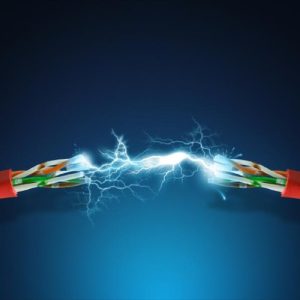 Now wiring comes in a lot of different forms and a lot of different formats. Most commonly in homes, you have this type of wiring which is called Romex. It has this outer shield, which is, in this case, is white covered. It also comes in different colors, not a big deal. Inside it, you’ll have a black wire, white wire, and green wire or a copper wire. The black wire is the hot wire, which is what carries electricity to your devices. The white wire is the neutral wire, which carries electricity away from the devices. The green wire or the copper is called the ground, and that’s your safety wire.
Now wiring comes in a lot of different forms and a lot of different formats. Most commonly in homes, you have this type of wiring which is called Romex. It has this outer shield, which is, in this case, is white covered. It also comes in different colors, not a big deal. Inside it, you’ll have a black wire, white wire, and green wire or a copper wire. The black wire is the hot wire, which is what carries electricity to your devices. The white wire is the neutral wire, which carries electricity away from the devices. The green wire or the copper is called the ground, and that’s your safety wire.
Now the importance of the ground wire is probably the most important one out of the three. If the black or white wire had a nick in it and touched the metal box, it would then energize the cover plate, and the screws and would make it dangerous for a kid or pet walking by, who could then get electrocuted.
How the ground wire works are if this box does become energized, because one of the wires is nicked or something goes wrong or a wire comes loose, a lot of different things could cause that. But, what it does, is it causes electricity to travel very fast through the ground wire back to the panel, which then causes a breaker to trip, which then turns off power to the circuit, so it’s no longer a hazard.
Electrical cables work by providing a low resistance path for the current to flow through. Electrical cables consist of a core of metal wire offering good conductivity such as copper or aluminum, along with other material layers including insulation, tapes, screens, armoring for mechanical protection, and sheathing. These additional layers are designed principally to allow the metal core to continue to conduct electrical current safely in the environment it is installed.
A good conductor is made of a material whose atomic structure has loosely bound electrons in its outer shell which can move across the atomic matrix of the material This movement of electrons is known as the current flow. On the contrary, good insulators have tightly bound electrons which makes it difficult for this current flow.
The simplest electrical cable may just be a metal conductor – these cables are used as overhead line wires manufactured without any insulating material around the conductor other than the air that surrounds the conductor. Overhead cables such as those used in the rail industry, require practical considerations to ensure that the cable is isolated from any means of accidentally grounding the electrical conductor (grounding the cable would see the current pass through it, electrocuting anyone in contact). Commonly used Rail OHL including Hornet and Cockroach have PVC insulated variations. Cables used either at ground level, within reasonable reach, or underground need to be effectively insulated to both maintain current flow through the cable and to be safe for users.
The amount of current which can effectively flow through the electrical cable will be determined by a combination of factors:
• the cross-sectional area of the conductor
• the resistance of the conductor material
• the insulation material
• the installation method or environment.
The effect of resistance to current flow is the heating of the conductor and the surrounding insulation layers. Overheating has the potential to cause the failure of the insulation material resulting in current short-circuiting, electric shock, or fire.


